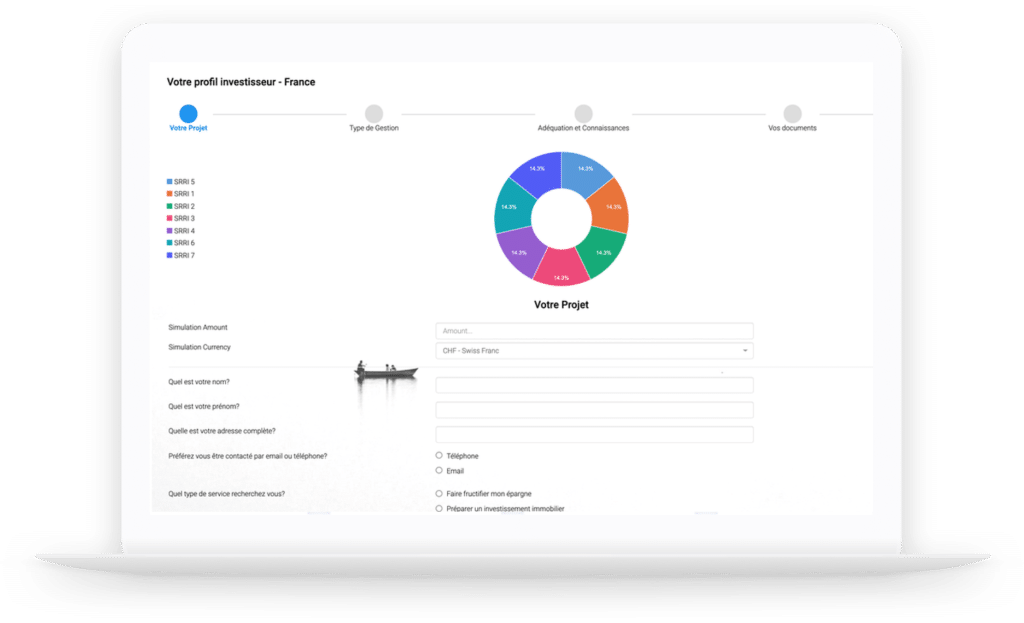Che cos'è il finanziamento dell'adattamento ai cambiamenti climatici?

Poiché gli effetti del cambiamento climatico diventano sempre più evidenti, è importante che le società finanziarie inizino ad adattare la loro pianificazione finanziaria per riflettere questi cambiamenti. Il modo più ovvio in cui il cambiamento climatico avrà un impatto sulle aziende è l'aumento dei costi associati alle attività commerciali. Ad esempio, se la sua azienda si affida a merci trasportate su camion, potrebbe registrare un aumento dei costi di spedizione a causa di condizioni meteorologiche estreme. In questo blog post, discuteremo di alcuni modi in cui può adattare i suoi piani finanziari per combattere gli effetti del cambiamento climatico e di come riflettere queste tendenze economiche globali in un portafoglio di investimenti.
1. Introduzione: Perché le aziende devono iniziare ad adattare i loro piani finanziari al cambiamento climatico.
2. Il modo più ovvio in cui il cambiamento climatico avrà un impatto sulle aziende: l'aumento dei costi.
3. Tre esempi specifici di come le aziende possono essere influenzate dal cambiamento climatico.
4. Cinque modi in cui le aziende possono adattare i loro piani finanziari per combattere gli effetti del cambiamento climatico.
5. Conclusione: L'importanza di agire ora per adattarsi al cambiamento del panorama aziendale provocato dal cambiamento climatico.
Perché i banchieri e i gestori patrimoniali devono iniziare ad adattare i loro piani finanziari al cambiamento del rischio climatico?
Come tutti sappiamo, gli effetti del cambiamento climatico sono già avvertiti dalle aziende e dalle industrie di tutto il mondo. L'aumento della frequenza e della gravità dei disastri naturali si ripercuote sulle infrastrutture, sulle catene di approvvigionamento e sui profitti. E con la popolazione mondiale che si prevede raggiungerà i 9,7 miliardi entro il 2050, la pressione sulle risorse continuerà ad aumentare. Affrontare il cambiamento climatico non è un argomento che potrebbe interessare tutti i suoi investitori, quindi dovrebbe essere pronto con due tipi di onboarding se utilizza questi elementi.
Consigliamo alle società finanziarie di utilizzare i moduli di onboarding di InvestGlass per riflettere queste strategie. InvestGlass è un'innovativa piattaforma di gestione patrimoniale progettata per aiutare gli investitori, le banche e i gestori patrimoniali ad adattare i loro piani finanziari per combattere il cambiamento climatico. Basata su un potente motore di intelligenza artificiale e su un'analisi avanzata dei dati, la piattaforma offre una suite completa di funzioni che consentono alle aziende di ottenere approfondimenti sui loro portafogli e di sviluppare strategie per mitigare i rischi associati al cambiamento climatico. InvestGlass offre uno strumento di onboarding digitale per presentare i portafogli di investimento e confrontarli con gli scenari di cambiamento climatico.
Con l'onboarding digitale di InvestGlass può :
- Creare moduli di onboarding su misura che riflettano le strategie e gli obiettivi del cambiamento climatico.
- Raccogliere e analizzare i dati dei clienti sulle loro politiche ambientali, investimenti, sforzi di sostenibilità e impronte di carbonio.
- Automatizzare i processi di reporting per garantire la conformità ai requisiti normativi.
- Genera rapporti personalizzati per gli investitori sull'impatto del cambiamento climatico.
Abbiamo scoperto che le società finanziarie di solito fanno riferimento ai seguenti argomenti:
- scenari climatici
- implicazioni per la stabilità finanziaria
- l'innalzamento del livello del mare
- impegno per le emissioni nette zero
- emissioni di carbonio
- gas a effetto serra
- incentivo dei regolatori finanziari
- politiche climatiche
- quadri normativi e incentivi

Ecco perché è più importante che mai che le aziende inizino ad adattare i loro piani finanziari per tenere conto degli effetti del cambiamento climatico. Così facendo, possono proteggersi dai rischi e trarre vantaggio dalle opportunità che derivano da un clima in evoluzione.
Ci sono diversi modi in cui le aziende possono adattare i loro piani finanziari al cambiamento climatico. Uno è quello di tenere conto dei rischi fisici, come i danni causati da uragani o inondazioni. Un altro è quello di tenere conto dei rischi di transizione, come i costi associati al passaggio a tecnologie a basse emissioni di carbonio. Infine, le aziende possono anche considerare i costi di opportunità, come il potenziale di investimento dei progetti di energia pulita.
Indipendentemente dall'approccio adottato dalle aziende, una cosa è chiara: il cambiamento climatico non è più una minaccia lontana, ma una realtà che deve essere presa in considerazione in tutte le decisioni finanziarie.
Il modo più ovvio in cui il cambiamento dei rischi legati al clima avrà un impatto sui mercati finanziari è l'aumento dei costi.
Il cambiamento climatico avrà un impatto profondo sulle aziende in diversi modi, il più significativo dei quali sarà l'aumento dei costi. Con le temperature globali destinate ad aumentare di una media di 2°C nei prossimi decenni, le aziende dovranno affrontare un aumento dei costi associati a tutto, dall'uso dell'energia e dell'acqua al trasporto e alle materie prime. Inoltre, dovranno affrontare maggiori rischi derivanti da eventi meteorologici estremi, che si prevede diventeranno più frequenti e intensi con il riscaldamento del pianeta. Alcuni clienti, in particolare la generazione Z, possono essere sensibili a questi rischi finanziari associati. La Generazione Z è costituita da ragazzi nati tra il 1996 e il 2009, che sono consapevoli del cambiamento climatico, motivo per cui è importante affrontarlo nel suo processo di onboarding.
Mentre alcune imprese saranno in grado di adattarsi a questi cambiamenti e persino di trovarvi delle opportunità, altre faranno fatica a farvi fronte. È probabile che l'impatto del cambiamento climatico ricada in modo sproporzionato sulle piccole imprese e su quelle dei Paesi in via di sviluppo, che spesso sono meno preparate a far fronte a tali shock. Di conseguenza, il cambiamento climatico potrebbe esacerbare le disuguaglianze esistenti e portare a un'ulteriore instabilità economica.
Il modo migliore per le aziende di prepararsi alle sfide poste dal cambiamento climatico è iniziare a pianificare ora. Ciò significa comprendere i rischi che devono affrontare e adottare misure per mitigarli. Significa anche assicurarsi di avere una copertura assicurativa adeguata in caso di danni causati da eventi meteorologici estremi. E significa investire in tecnologie verdi che possono aiutare a ridurre l'impronta di carbonio. Le aziende che non agiscono ora rischiano di trovarsi in una posizione di svantaggio competitivo negli anni a venire.
Tre esempi specifici di come le aziende possono essere influenzate dal cambiamento climatico.
Le considerazioni sul clima avranno un impatto profondo sulle aziende di tutto il mondo. In realtà, lo sta già facendo. Ecco tre esempi specifici di come le aziende possono essere influenzate dal cambiamento climatico:
1. Aumento dei costi: Molte aziende stanno già vedendo aumentare i loro costi a causa del cambiamento climatico. Ad esempio, quelle del settore agricolo sono colpite duramente dalla siccità, che sta diventando più comune e più grave a causa del cambiamento climatico. Ciò comporta un aumento dei prezzi degli alimenti e di altre materie prime. Anche le tempeste e le inondazioni stanno diventando più frequenti e più gravi, causando danni alle infrastrutture e determinando un aumento dei premi assicurativi. Tutti questi fattori stanno aumentando i costi per le aziende, che alla fine saranno trasferiti ai consumatori sotto forma di prezzi più alti.
2. Interruzioni delle catene di approvvigionamento: Il cambiamento climatico sta causando anche interruzioni nelle catene di approvvigionamento. Ad esempio, gli eventi meteorologici estremi possono danneggiare le infrastrutture e interrompere i trasporti, con conseguente carenza di beni e materiali. Questo può causare gravi problemi alle aziende che si affidano a metodi di produzione just-in-time. Inoltre, con il cambiamento del clima, alcune aree possono diventare troppo calde o troppo secche per la coltivazione di determinati prodotti, interrompendo le catene di approvvigionamento agricolo.
3. Danno alla reputazione del marchio: Man mano che i consumatori diventano più consapevoli dei rischi del cambiamento climatico, tengono sempre più in considerazione il bilancio ambientale di un'azienda quando prendono decisioni di acquisto. Ciò significa che le aziende che non sono ritenute sufficientemente impegnate nella lotta al cambiamento climatico o che sono percepite come un fattore che vi contribuisce, potrebbero vedere danneggiata la loro reputazione. Ciò potrebbe comportare una riduzione delle vendite e dei ricavi, oltre a difficoltà nell'attrarre e trattenere clienti e dipendenti.

Cinque modi in cui le aziende possono adattare i loro piani finanziari per combattere gli effetti del cambiamento climatico.
Il cambiamento climatico sta già avendo un impatto sulle aziende di tutto il mondo e tale impatto non farà che accentuarsi negli anni a venire. Di conseguenza, è sempre più importante che le aziende adattino i loro piani finanziari per tenere conto degli effetti del cambiamento climatico e gli investitori dovranno individuare questi cinque modi. Ecco cinque modi in cui le aziende possono farlo:
1. Incorporare i rischi legati al clima nella pianificazione finanziaria: Molte aziende non tengono ancora conto dei rischi legati al clima nella loro pianificazione finanziaria, ma questo è un aspetto che deve cambiare. La maggior parte delle aziende non dispone di un'analisi dei rischi sistemici, di una task force o di rapporti completi sui propri asset fisici. Il cambiamento climatico avrà un'ampia gamma di impatti sulle aziende, dall'aumento dei costi associati a eventi meteorologici estremi alle interruzioni delle catene di approvvigionamento. Incorporando questi rischi nella pianificazione finanziaria, le aziende possono essere meglio preparate ad affrontarli quando si presenteranno.
2. Investire in infrastrutture resistenti al clima: Un altro modo in cui le aziende possono adattare i loro piani finanziari per combattere gli effetti del cambiamento climatico è investire in infrastrutture resistenti al clima. Ciò include aspetti come l'impermeabilizzazione degli edifici, l'installazione di generatori di energia di riserva e la creazione di spazi verdi che possano aiutare ad assorbire le precipitazioni in eccesso. Questi investimenti possono aiutare a proteggere le aziende dall'aumento della frequenza e dell'intensità degli eventi meteorologici estremi.
3. Inserire le considerazioni sul cambiamento climatico nel processo decisionale: Molte decisioni aziendali - da dove ubicare una nuova struttura a quale tipo di prodotti o servizi offrire - saranno influenzate dal cambiamento climatico. Pertanto, è importante che le aziende inseriscano le considerazioni sul cambiamento climatico nei loro processi decisionali. Ciò significa prendere in considerazione aspetti come il futuro innalzamento del livello del mare e i cambiamenti nella temperatura locale e nei modelli di precipitazione, quando si prendono decisioni che potrebbero avere implicazioni a lungo termine.
4. Inserire il prezzo del carbonio nei piani aziendali: Un numero crescente di giurisdizioni sta imponendo un prezzo al carbonio, attraverso tasse o sistemi cap-and-trade. Di conseguenza, le aziende devono tenere conto della tariffazione del carbonio nei loro piani e prevedere i potenziali aumenti dei costi che potrebbero derivarne. La tariffazione del carbonio avrà anche un impatto sulle decisioni di investimento, in quanto le aziende cercheranno progetti che le aiutino a ridurre le emissioni e a raggiungere gli obiettivi di emissione eventualmente in vigore.
5. Sostenere le misure di politica pubblica per affrontare il cambiamento climatico: Oltre ad agire in prima persona, le aziende dovrebbero anche sostenere le misure di politica pubblica che mirano ad affrontare il cambiamento climatico. Questo include cose come le tasse sul carbonio o i sistemi cap-and-trade, così come le misure per promuovere le energie rinnovabili e l'efficienza energetica. Sostenendo tali misure, le aziende possono contribuire a creare le condizioni necessarie per un'economia a basse emissioni di carbonio e a ridurre l'impatto complessivo del cambiamento climatico.

Perché il settore finanziario dovrebbe agire ora per adattarsi al cambiamento del panorama degli affari provocato dai rischi climatici.
Poiché gli effetti del cambiamento climatico diventano sempre più evidenti, è chiaro che le aziende devono iniziare ad agire per adattarsi. Il cambiamento del panorama aziendale provocato dal cambiamento climatico avrà un impatto importante su molti aspetti delle operazioni, dalla gestione della catena di approvvigionamento alla sicurezza dei dipendenti.
Una delle cose più importanti da fare per le aziende è iniziare a pianificare le interruzioni. Il cambiamento climatico sta già causando eventi meteorologici estremi che possono interrompere le attività aziendali. Pianificando in anticipo e disponendo di piani di emergenza, le aziende possono ridurre al minimo l'impatto di queste interruzioni.
Un'altra considerazione importante per le aziende è la loro catena di approvvigionamento. Con l'aumento delle temperature globali, alcune regioni diventeranno sempre più inabitabili o difficilmente accessibili. Questo potrebbe portare a interruzioni nelle catene di approvvigionamento e a una diminuzione della disponibilità di alcune materie prime. Le aziende devono essere consapevoli di questi rischi e pianificare di conseguenza.
Infine, le aziende devono considerare la sicurezza dei loro dipendenti. Gli eventi meteorologici estremi possono rappresentare un pericolo per i lavoratori e, con il continuo aumento delle temperature, questi pericoli non potranno che aumentare. Le aziende devono mettere in atto politiche e procedure per garantire che i dipendenti siano al sicuro durante i periodi di eventi meteorologici estremi. Può aggiungere questi video nelle pagine di onboarding per presentare ai suoi investitori come le aziende sono
Il cambiamento climatico è una sfida importante a cui le aziende devono iniziare a prepararsi fin da ora. Adottando misure di adattamento, le aziende possono proteggersi dagli effetti del cambiamento climatico e assicurarsi di rimanere operative durante i periodi di tempo estremo.
1. Introduzione: Perché le aziende devono iniziare ad adattare i loro piani finanziari al cambiamento climatico.
Mentre il mondo continua a sperimentare gli effetti del cambiamento climatico, le aziende iniziano a sentirne il peso in termini di aumento dei costi e di interruzioni delle loro attività. Anche se alcuni potrebbero essere tentati di cavalcare la tempesta, la realtà è che il panorama imprenditoriale sta cambiando e coloro che non adattano i loro piani finanziari di conseguenza rischiano di trovarsi in una posizione di svantaggio competitivo.
2. Il modo più ovvio in cui il cambiamento climatico avrà un impatto sulle aziende: l'aumento dei costi.
Uno dei modi più immediati in cui il cambiamento climatico avrà un impatto sulle aziende è l'aumento dei costi. Questo potrebbe manifestarsi in diversi modi, come l'aumento dei prezzi delle materie prime, l'aumento dei costi energetici e l'aumento dei premi assicurativi. Per le aziende che già operano con margini ridotti, questi costi aggiuntivi potrebbero essere sufficienti a spingerle oltre il limite.
3. Tre esempi specifici di come le aziende possono essere influenzate dal cambiamento climatico.
Per fornire alcuni esempi concreti di come il cambiamento climatico potrebbe avere un impatto sulle aziende, analizziamo tre settori specifici che probabilmente ne risentiranno: agricoltura, turismo ed edilizia.
Se gli eventi meteorologici estremi diventano più comuni, possiamo aspettarci di vedere un aumento dei danni alle infrastrutture come strade, ponti ed edifici. Ciò comporterà un aumento dei costi di riparazione e sostituzione per le aziende che operano nel settore delle costruzioni.
Come utilizzare InvestGlass per adattare i piani finanziari alla lotta contro il cambiamento climatico?
I suoi investitori potrebbero non essere lettori quotidiani del Wall Street Journal, ma guardare Youtube o TikTok ogni giorno. Il suo onboarding dovrebbe essere adattato ai diversi segmenti di clienti. Può aggiungere dei "tag" ai clienti che comprendono questo specifico rischio finanziario, per offrire poi contenuti di marketing specifici.
L'integrazione del rischio climatico nel portafoglio è possibile tramite lo strumento del portafoglio modello. I prezzi delle attività vengono caricati tramite la sua fonte bancaria o il suo feed finanziario tradizionale, per poi regolare i pesi per costruire il suo modello personale. Colleghi questo portafoglio modello al modulo digitale per creare un'esperienza di onboarding coinvolgente.

Se ha un portafoglio esistente, lo strumento di ribilanciamento di InvestGlass faciliterà lo scambio di titoli. Può trasformare un portafoglio classico in un portafoglio abilitato ai rischi del cambiamento climatico in pochi minuti. Il ribilanciamento del portafoglio può essere impostato con frequenza giornaliera, settimanale o mensile.
Infine, InvestGlass le fornisce tutti i report e le metriche finanziarie di cui ha bisogno per misurare la sua performance e garantire che la sua esposizione ai rischi del cambiamento climatico sia in linea con i suoi obiettivi. Ad esempio, il nostro rapporto ESG integra i dati ambientali delle aziende nei tradizionali KPI finanziari, come il rendimento degli asset o il rendimento del capitale.
In conclusione, InvestGlass fornisce gli strumenti per aiutare i pianificatori finanziari e gli investitori ad adattare i loro piani finanziari per combattere il cambiamento climatico. Armati delle giuste informazioni, i suoi clienti possono prendere decisioni informate che proteggeranno il loro patrimonio e assicureranno un successo continuo in un mondo che cambia.
finanziamento dell'adattamento, impatto del cambiamento climatico sulla pianificazione finanziaria